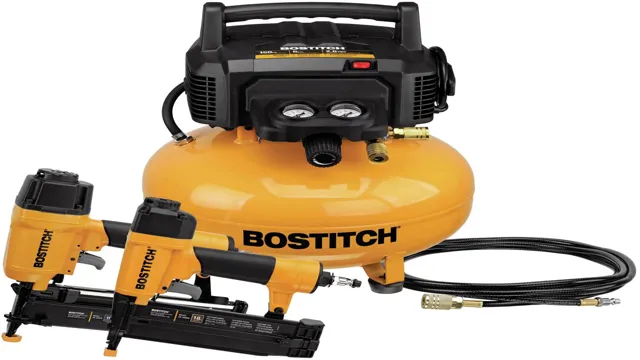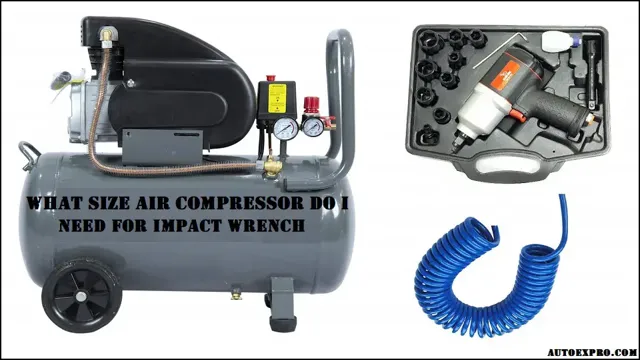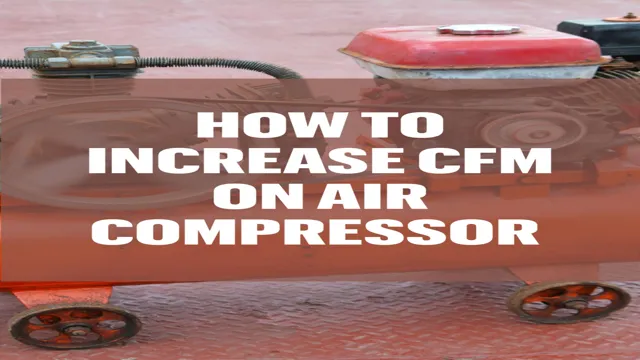
If you’re an avid DIYer or mechanic, you know the importance of having the right tools in your workshop. Among those essential tools is an impact wrench that helps you fasten or loosen nuts and bolts with ease. But to ensure your impact wrench performs at its best, you need to pair it with the right air compressor.
With so many options in the market, it can be daunting to choose the one that best fits your needs. But worry not, as we have got you covered. In this blog, we’ll guide you through the factors you need to consider when choosing the right air compressor for your impact wrench, so you can get the job done effectively and efficiently.
Understanding Air Compressor Ratings
When it comes to using an impact wrench, you need an air compressor that can keep up with the tool’s demand for air pressure and volume. The size of the air compressor necessary for an impact wrench depends on the wrench’s size and the tasks you need to accomplish. If you have a small impact wrench, you can get away with a smaller compressor, but for larger wrenches and more demanding tasks, a bigger compressor is necessary.
Generally, an impact wrench requires a compressor with a minimum CFM (cubic feet per minute) rating of 4-5 CFM at 90 PSI (pounds per square inch). It’s essential to keep in mind that the compressor’s rating is just as important as the wrench’s rating because if the compressor cannot meet the wrench’s requirements, the tool will not work properly. Therefore, it’s crucial to understand air compressor ratings such as CFM, PSI, and horsepower to ensure you get the right compressor for your impact wrench needs.
CFM and PSI Ratings
Air compressor ratings can be confusing, especially if you’re not familiar with the terms CFM and PSI. CFM stands for cubic feet per minute, and it’s a measure of how much air an air compressor delivers. PSI, on the other hand, stands for pounds per square inch, and it’s a measure of the pressure of the air delivered by the compressor.
Understanding these ratings is crucial in selecting the right compressor for your needs. For example, if you’re planning to use your compressor for heavy-duty tasks like sanding or painting, you’ll need a compressor with a high CFM to deliver the air required for those tasks. Conversely, if you’re using your compressor for simple tasks like inflating tires, a lower CFM should be sufficient.
Similarly, PSI is crucial in ensuring that your tools operate correctly. For example, if you’re using a tool that requires high pressure to operate, make sure your compressor can deliver that pressure. Understanding these ratings allows you to get the most out of your air compressor and ensure that you’re using it safely and effectively.

Impact Wrench Size and Power
When it comes to using an impact wrench, understanding the size and power of your air compressor is vital. Air compressors are rated based on their cubic feet per minute (CFM) and pounds per square inch (PSI) output, which determines how much power they can supply to your tools. Generally, the larger the size of your impact wrench, the higher PSI and CFM rating you’ll require from your air compressor.
It’s essential to choose an air compressor that can power your impact wrench effectively without causing it to overwork or suffer from low performance. In essence, your air compressor acts as the powerhouse that supplies the necessary force behind your impact wrench, enabling it to loosen or tighten bolts and nuts with ease. By understanding these ratings, you’ll be better equipped to choose the right air compressor that provides the required power to your impact wrench, allowing you to get the job done quickly and effectively.
Calculating Your Air Compressor Size
If you’re wondering what size air compressor to use with your impact wrench, there are a few factors to consider. First, you’ll need to know how much air flow your impact wrench requires. This is typically measured in cubic feet per minute (CFM) and can vary depending on the brand and model of the wrench.
Once you have this information, you’ll want to choose an air compressor that can supply that amount of CFM consistently. Keep in mind that using an air compressor that’s too small for your wrench can cause it to perform poorly or even damage it over time. On the other hand, using an air compressor that’s too large can be wasteful and inefficient.
It’s important to find the right balance to get optimal performance and efficiency from your air tool. So, what size air compressor for impact wrench? The answer depends on your specific impact wrench and its CFM requirements.
Air Compressor Size Formula
Air Compressor Size Formula If you’ve ever needed to use an air compressor, you know just how important it is to have the right size on hand. Too small, and you’ll find yourself waiting for the tank to refill more often than not. Too large, and you’ll have wasted both space and money.
So how do you calculate your ideal air compressor size? The formula for doing so is relatively simple. You’ll need to determine the CFM (or cubic feet per minute) requirements of your tools, and then multiply that figure by
This will give you the minimum CFM rating your air compressor needs to have. Of course, this is just a starting point. Depending on the types of tools you’ll be using and the amount of time you’ll spend using them, you may need to adjust your calculations accordingly.
But with this basic formula in hand, you’ll be well on your way to finding the perfect air compressor for your needs.
Example Calculation
Calculating the size of your air compressor can seem daunting, but it’s actually a straightforward process. The first thing you need to determine is the amount of air flow your tools require. This is typically measured in cubic feet per minute (CFM).
Once you know the CFM requirements of your tools, you can then factor in how many tools you will be using simultaneously. This will help you determine the total CFM output needed from your air compressor. Additionally, you’ll want to consider the pressure requirements of your tools and ensure that your compressor can provide enough pressure to meet those needs.
It’s also important to take into account any future tool purchases that may require more CFM output. With all of these factors in mind, you can use an air compressor sizing calculator or consult with a professional to determine the right compressor size for your needs. Remember, it’s always better to err on the side of a slightly larger compressor to ensure you have enough power for your tools.
Considerations for Continuous Use
When it comes to calculating the size of your air compressor for continuous use, there are a few factors to consider. The main keyword to keep in mind here is “continuous use,” which means you’ll need an air compressor that is built to handle the demands of frequent, extended operations. One important consideration is the CFM (cubic feet per minute) rating of the compressor, which tells you how much air the compressor can deliver over time.
You’ll need to calculate the CFM requirements of your tools and equipment to ensure that your air compressor can keep up with demand. Additionally, you’ll want to look at the tank size of the compressor, as a larger tank can help reduce cycle times and increase overall efficiency. Other factors to consider include the duty cycle, horsepower, and overall build quality of the compressor.
By taking all of these factors into account, you can choose an air compressor that is perfectly suited to your needs for continuous use.
Top Air Compressor Options for Impact Wrenches
When it comes to using an impact wrench, choosing the right size air compressor is crucial for optimal performance. If you’re on the hunt for an air compressor specifically for your impact wrench, consider the CFM (cubic feet per minute) and PSI (pounds per square inch) ratings. The CFM rating should match or exceed the requirements of your wrench, while the PSI rating should be high enough to handle the load.
One great option to consider is the DeWalt D55168, which has a 0 CFM at 90 PSI rating, making it perfect for most impact wrenches. Another top choice is the Makita MAC2400, with a higher CFM rating of
2 at 90 PSI and a powerful 5 horsepower motor. Whether you’re a DIY enthusiast or a professional mechanic, investing in a quality air compressor will make your impact wrench more efficient and reliable.
So, before you start working on your next project, make sure you have the right air compressor to match your wrench.
1. Makita MAC2400 Big Bore 2.5 HP Air Compressor
If you are in search of an air compressor for your impact wrench, the Makita MAC2400 Big Bore 5 HP Air Compressor should definitely be on your radar. This air compressor is designed to provide consistent and powerful air pressure, which is essential for efficient use with an impact wrench.
With a 5 HP motor and an impressive 2-gallon twin-stacked tank, this air compressor provides enough air pressure to easily power your impact wrench through tough bolts and lug nuts.
Additionally, the Big Bore engineered pump cylinder and piston provide faster recovery time, allowing you to work uninterrupted for longer periods of time. Plus, this air compressor operates with low noise and is built with a roll-cage construction to help protect against any accidental damage, making it a great investment for any mechanic or DIY enthusiast. So, if you want reliable power and efficiency from your air compressor, the Makita MAC2400 Big Bore
5 HP Air Compressor is a top option to consider.
2. California Air Tools 8010 Ultra Quiet Air Compressor
Impact wrenches require a lot of power to function effectively, and to get that power, you need an air compressor that can deliver. One of the top options for an air compressor to power an impact wrench is the California Air Tools 8010 Ultra Quiet Air Compressor. This compressor is specifically designed to be ultra-quiet, which is a huge plus if you’re working in a busy or tight space that requires minimal noise.
Additionally, it has a large 8-gallon tank, which means you won’t have to stop and refill it very often, saving you precious time and effort. This compressor also has a powerful motor, providing 0 horsepower, which is more than enough to help your impact wrench tackle any project you throw at it.
Overall, the California Air Tools 8010 is an excellent choice for anyone who needs a reliable and quiet air compressor to power their impact wrench.
3. DEWALT DWFP55126 6-Gallon Air Compressor
When it comes to using an impact wrench, having the right air compressor can make all the difference. One top option to consider is the DEWALT DWFP55126 6-Gallon Air Compressor. This compressor has a maximum pressure of 165 PSI, which is ideal for powering an impact wrench.
It is also designed with a high-efficiency motor, which helps to minimize noise and increase the overall lifespan of the compressor. Additionally, the DEWALT DWFP55126 has a compact and lightweight design, making it easy to transport and store. With its oil-free pump, maintenance is a breeze, ensuring that you can keep working without interruptions.
Overall, if you’re looking for a reliable and efficient air compressor for your impact wrench, the DEWALT DWFP55126 is definitely worth considering.
Conclusion: Finding the Perfect Air Compressor for Your Impact Wrench
So, what’s the deal with finding the right size air compressor for your impact wrench? Well, it all comes down to power and efficiency. You want an air compressor that can provide enough pressure and volume to handle your impact wrench’s demands, without wasting energy or costing you a fortune. In other words, it’s like Goldilocks and the Three Bears – you need an air compressor that’s just right.
So, whether you’re a professional mechanic or a DIY enthusiast, do your research, consider your needs, and invest in a compressor that can keep up with your impactful ambitions.”
FAQs
What size air compressor is needed for an impact wrench?
Typically, a 30-gallon air compressor is recommended for an impact wrench, but it all depends on the specific torque requirements of your wrench.
Can I use a small air compressor for my impact wrench?
It is not recommended to use a small-sized air compressor for an impact wrench as it may not provide enough power and cause damage to your tool.
How much PSI do I need for an impact wrench?
The minimum air pressure requirement for an impact wrench is 90 PSI (pounds per square inch), but it can vary based on the wrench’s torque requirements.
Should I use an oil-lubricated or oil-free air compressor for my impact wrench?
Both types of air compressors are suitable for use with an impact wrench, but oil-lubricated compressors tend to last longer and require less maintenance.
Can I use a portable air compressor for an impact wrench?
Yes, you can use a portable air compressor for an impact wrench, but make sure that the compressor has a large enough tank size and output pressure to meet your tool’s requirements.
What is the average CFM requirement for an impact wrench?
The average CFM (cubic feet per minute) requirement for an impact wrench is around 4-5 CFM at 90 PSI, but it can vary depending on the wrench’s torque rating.
Is it okay to use a higher CFM air compressor than recommended for an impact wrench?
Yes, using a higher CFM air compressor than recommended for your impact wrench can actually improve your tool’s performance, but be sure not to exceed the maximum PSI rating of your wrench.







